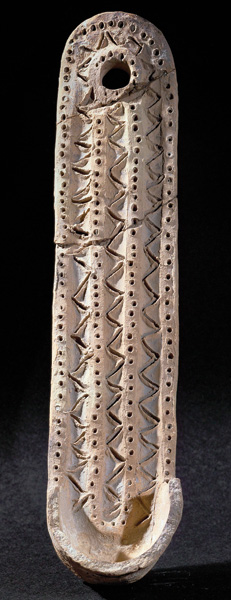
A. Phoenician juicer
B. Israelite shoehorn
C. Babylonian calendar device
D. Egyptian foot measure
E. Cypriot offering bracket
Answer: E) Cypriot offering bracket
The precise function of this strange, 14-inch-tall ceramic object, often called a “wall bracket,” has long puzzled archaeologists. The piece’s oblong shape, flat back and prominent upper hole indicate that it was most likely hung and displayed on a wall or other flat surface, while the scoop-shaped arm protruding from its base may have been intended to hold small amounts of libations or incense. Archaeologist Nava Panitz-Cohen of the Hebrew University of Jerusalem suggests that such decorated brackets were used primarily by Cypriots as offering stands for small, private family rituals held inside their homes.1
This bracket, abstractly decorated with raised ridges, incised zigzags and rows of punctured dots, comes from the Iron Age I level at Megiddo (c. 1200–1000 B.C.E.). Much more elaborate examples, topped with bull heads or nude female figurines and decorated with intricate geometric patterns, have been discovered in abundance in Late Bronze Age Cyprus and at Late Bronze Age sites elsewhere in the Levant where Cypriot traders were active. Since almost all of these examples were made in Cyprus, the brackets must have served the private ritual needs of Cypriots living throughout the eastern Mediterranean. As Panitz-Cohen has argued, the presence of locally made brackets at Iron Age I Megiddo (and a handful of other sites, including Beth-Shean) indicates that a small but vibrant Cypriot community remained in Palestine even after the collapse of Mediterranean commerce and trade at the end of the Late Bronze Age, around 1200 B.C.E.
MLA Citation
Endnotes
Lawrence E. Stager, “Chariot Fittings from Philistine Ashkelon,” in Seymour Gitin, J. Edward Wright and J.P. Dessel, eds, Confronting the Past: Archaeological and Historical Essays on Ancient Israel in Honor of William G. Dever (Winona Lake, IN:Eisenbrauns, 2006), pp. 169–176. See also Trude Dothan and Alexandra S. Drenka, “Linchpins Revisited,” in J. David Schloen, ed., Exploring the Longue Durée: Essays in Honor of Lawrence E. Stager (Winona Lake, IN: Eisenbrauns, 2009), pp. 97–101.

